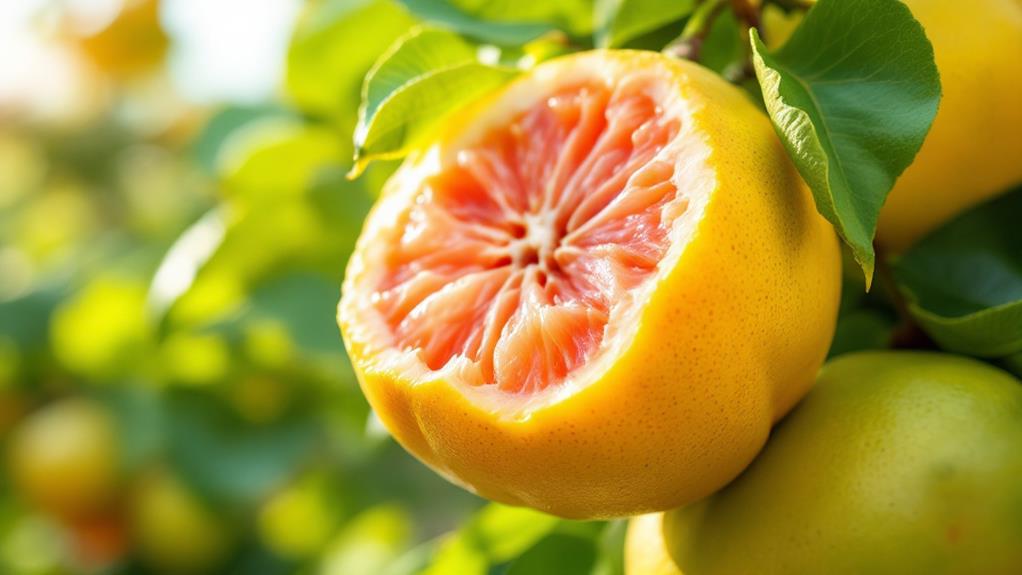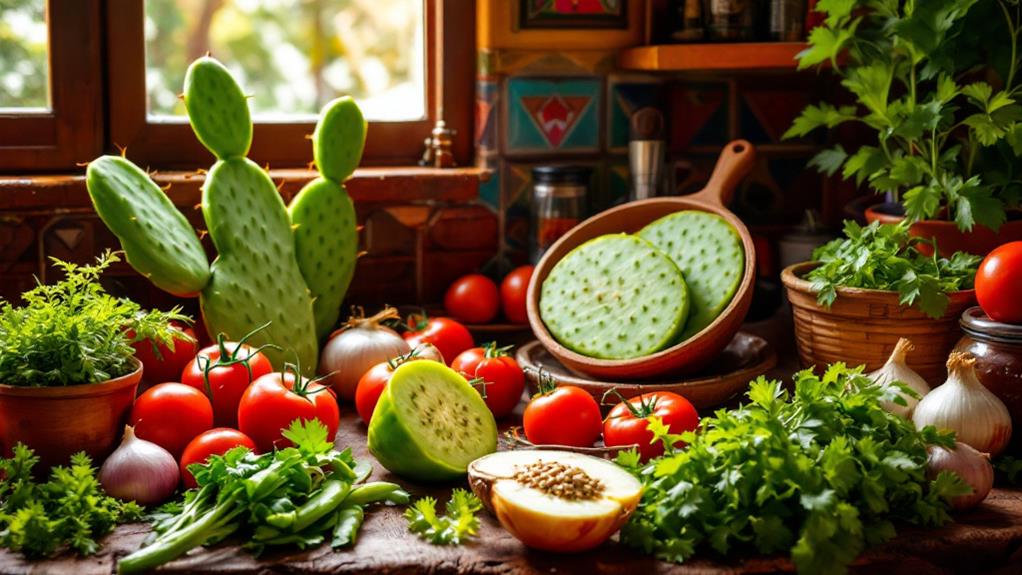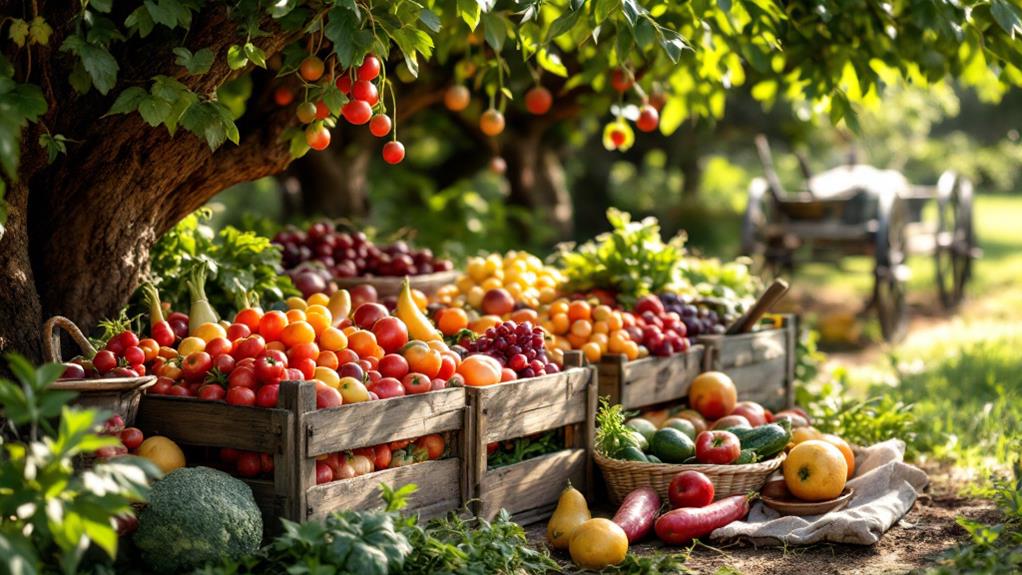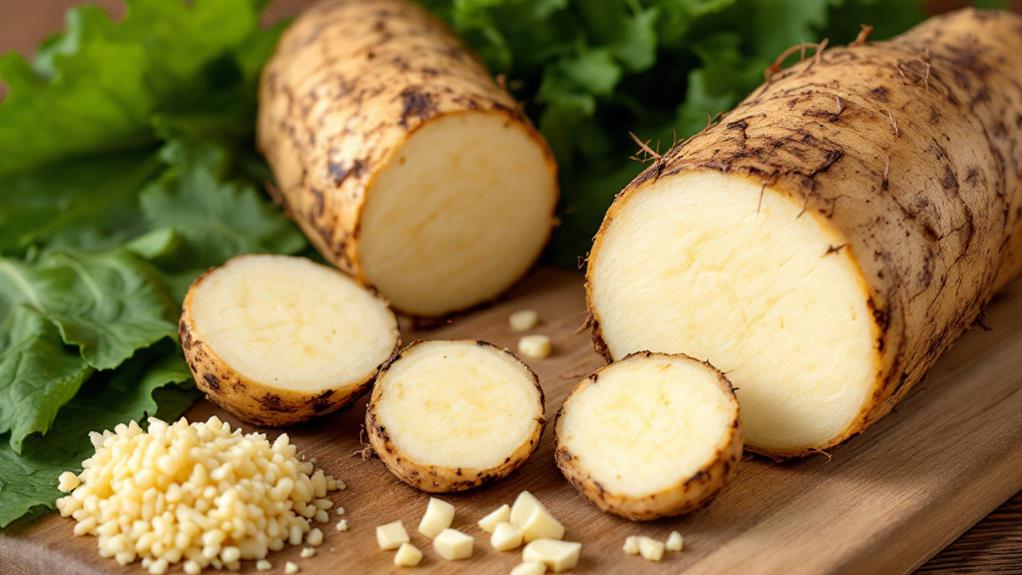Interesting Facts About South American Fruits You Didn’t Know
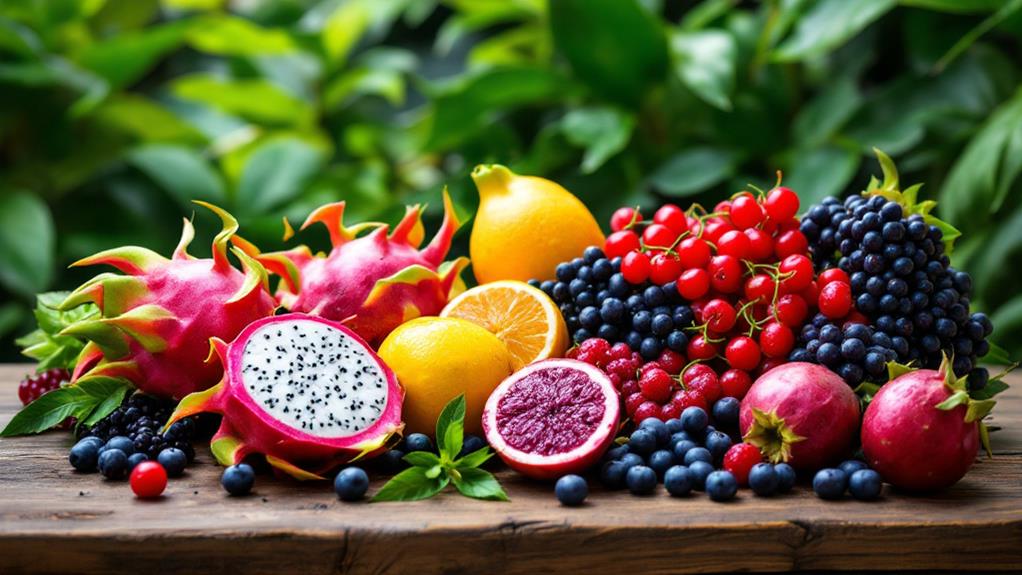
South American fruits offer a world of lively tastes and nutritional wonders. Imagine the cherimoya's creamy flesh blending banana and pineapple flavors in your smoothies, or the camu camu's staggering vitamin C content elevating your immune health. Uncover how passion fruit can improve both sweet and savory dishes with its unique flavor. Don't forget the rare guanábana, known for potential anticancer effects. These fruits aren't just tasty but are loaded with fiber, antioxidants, and crucial vitamins. You've only scratched the surface of their fascinating culinary and health benefits, inviting more exploration into this tropical bounty.
Diverse Flavors and Textures
South American fruits frequently surprise with their diverse flavors and textures, offering a culinary immersion in every bite. These tropical gems, like the cherimoya, captivate with a unique flavor profile blending banana and pineapple. You'll find its sweet flavor perfect for smoothies and desserts, making it a delightful enhancement to your culinary repertoire. Then there's the lulo, a favorite in Ecuador and Colombia, with its tangy taste reminiscent of pineapple and lemon. This exotic fruit is often enjoyed in invigorating drinks, adding a zesty kick to your beverages.
Pitaya, or dragon fruit, is another showstopper with its lively pink skin and mildly sweet flavor. Its visually striking white or red flesh, speckled with tiny black seeds, makes it a feast for both the eyes and the palate. Likewise, the carambola, or star fruit, slices into a distinctive star shape, offering a sweet and sour flavor. Rich in Vitamin C, it's perfect for salads and drinks, adding both health benefits and a burst of flavor.
Cultural Significance in Cuisine
In the rich tapestry of South American cuisine, tropical fruits hold a special place, woven into the very essence of cultural dining traditions. In Colombian cuisine, these fruits are more than just ingredients; they're a ceremonial start to your meal, setting a flavorful tone that's both inviting and lively. Imagine beginning your dining experience with a burst of diverse flavors, thanks to a beautifully arranged platter of tropical fruits.
You'll find fruits like lulo and cherimoya making their way into invigorating beverages and desserts, spotlighting their cultural significance in local culinary practices. These fruits aren't just about taste; they bring a balance to meals, especially when paired with deep-fried dishes. The sweetness of tropical fruits contrasts perfectly with savory, crunchy textures, creating a harmonious balance that's a signature of Colombian cuisine.
Markets across Latin America are a feast for the senses, showcasing the region's rich agricultural heritage and cultural appreciation for these diverse flavors. By incorporating tropical fruits into traditional recipes and even traditional medicine, communities uphold their health and cultural identity. So, when you investigate South American cuisine, you're not just tasting food—you're experiencing a lively culture.
Nutritional and Health Benefits
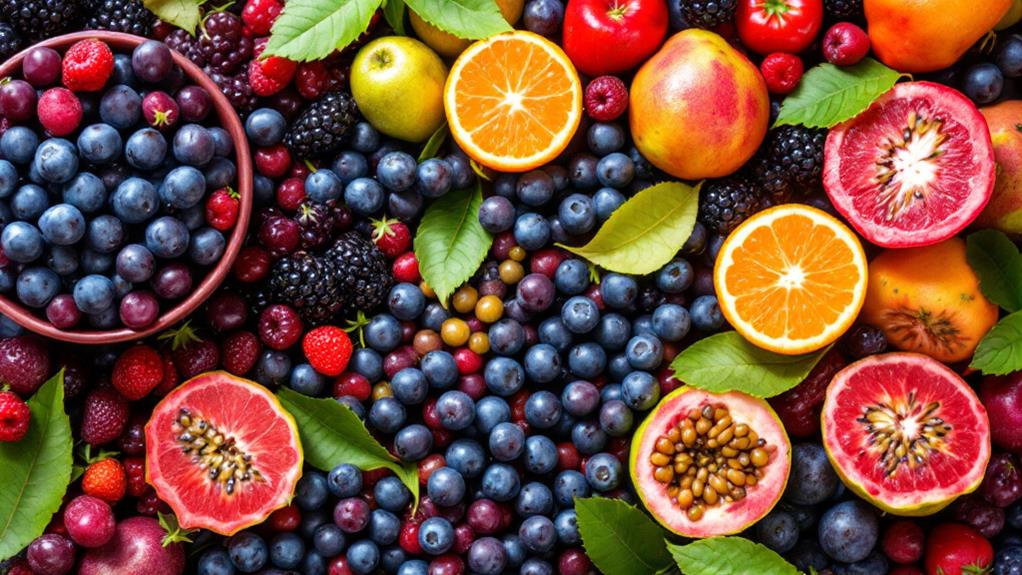
As you investigate the lively world of South American fruits, their nutritional and health benefits stand out just as prominently as their cultural significance. Take Açaí, for example. It's packed with antioxidants and fiber, potentially helping you ward off chronic diseases linked to inflammation, like cardiovascular disease and diabetes. Then there's Camu Camu, a true powerhouse regarding vitamin C. Just a tablespoon offers a staggering 2,360% of your daily value, making it a formidable ally for enhancing your immune system.
Guava is another gem, giving you over 10% of your daily fiber needs per fruit. This fiber supports your digestive health and, thanks to its high vitamin C content, aids in iron absorption. Passion Fruit adds its own benefits to the mix. It's low in calories but rich in potassium, iron, and vitamin C, contributing to general health and disease prevention. Ultimately, Cherimoya provides nearly 5 grams of fiber per cup. This helps with digestion and blood sugar regulation. Plus, its delightful banana-pineapple flavor is an added bonus. Exploring these fruits offers not only a taste adventure but a healthful one too.
Rare and Unique Varieties
Expedition into the domain of rare and unique South American fruits, where exotic flavors and intriguing textures await. Plunge into the Amazon Jungle and uncover the Araza, a rare citrus fruit that's too acidic to eat raw but perfect for zesty juices and ice creams. Its tangy profile will surprise your taste buds, offering a revitalizing twist on traditional citrus.
Next, investigate the lively lands of Colombia and Ecuador with Lulo, also known as Solanum quitoense. This exotic fruit combines the tartness of pineapple with a hint of lemon. Often blended into a rejuvenating drink called lulada, it's a must-try for any fruit enthusiast seeking a new taste experience.
The Cherimoya, native to South America, offers a creamy texture and flavors reminiscent of banana and pineapple. However, beware of its large black seeds, which you can't eat. Despite this, the fruit's sweet, custard-like flesh makes it a favorite treat.
Camu Camu might just be the powerhouse of exotic fruits with an astonishing vitamin C content, making it a potent nutrient source. Finally, there's Feijoa or pineapple guava, which boasts a sweet flavor and is perfect for jams and desserts. Its cultivation remains limited outside its native regions, enhancing its allure.
Increasing Global Popularity
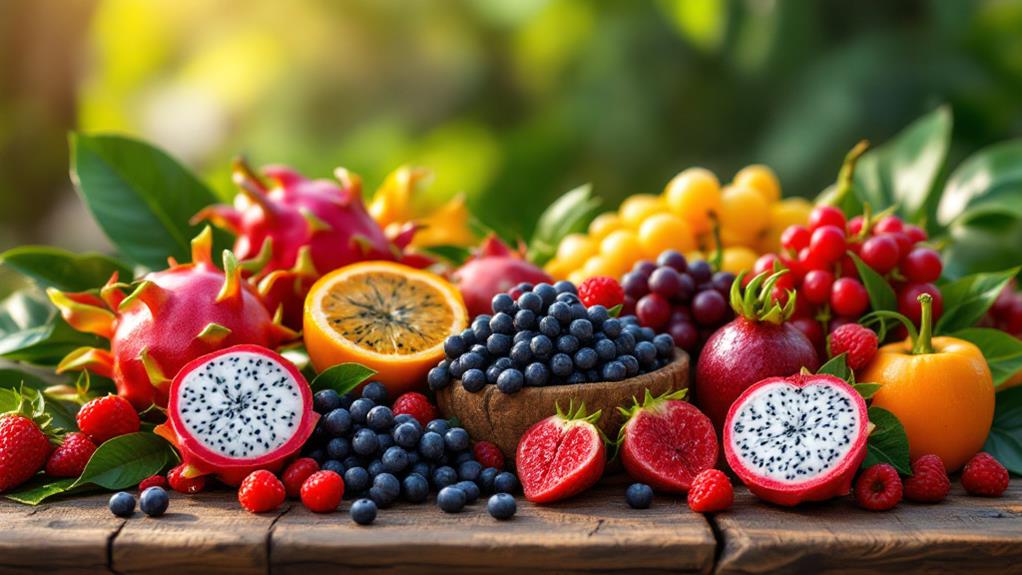
While rare and unique South American fruits offer a wealth of exotic flavors, their increasing global popularity is enchanting the world. There's a clear rise in global demand, as shown by the 2% increase in export volume and 10% rise in value from 2014 to 2015. This trend reflects a growing appreciation for these lively, exotic fruits. Ecuador, for instance, stands out as a major exporter, with its pineapples and bananas leading the charge in the global fruit market.
In the U.S., gourmet supermarkets are expanding their tropical fruit selections, making these South American delights more accessible to you. This means you can easily uncover a variety of flavors without leaving your hometown. The healthy eating trend is driving this growth too, with superfoods like acai and camu camu capturing your attention for their nutritional benefits.
Social media and food tourism are also catalysts for the surge in interest. They inspire culinary experimentation and innovation, encouraging you to try new recipes and flavors. With each bite, you're not just tasting a fruit; you're savoring a piece of South America's rich agricultural heritage. Enjoy the adventure!
Adaptations to Environment
Adapting to diverse environments, South American fruits showcase remarkable resilience and versatility. You'll find that fruits like the açaí berry have developed high antioxidant levels, essential for surviving in the tropical rainforest's humid conditions. These antioxidants protect the fruit from oxidative stress, guaranteeing its survival and health. Meanwhile, the cherimoya fruit thrives in the high-altitude regions of the Andes, adapting to cooler temperatures with its sweet, creamy flesh that can withstand significant temperature variations.
Guanábana, also known as soursop, has a thick skin and fibrous interior—an adaptation to the frequent rainfall of tropical climates. This structure guarantees it remains intact and viable for consumption. The lively pitanga, or Brazilian cherry, uses its sweet-tart flavor and striking color to attract birds and insects, aiding in effective pollination and seed dispersal in its native environment.
- Açaí Berry: High antioxidants protect against oxidative stress in tropical rainforests.
- Cherimoya: Sweet flesh thrives in cooler, high-altitude Andes.
- Guanábana: Thick skin and fibrous structure endure tropical rainfall.
- Pitanga: Lively color and flavor attract pollinators.
Each fruit's unique adaptations allow it to flourish in the varied environments of South America.
Culinary Uses and Innovations
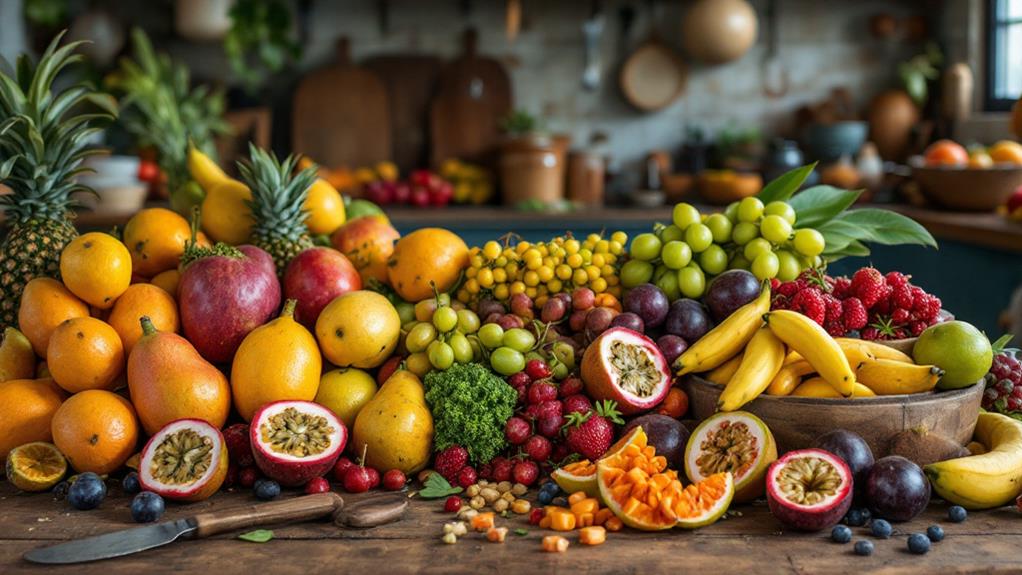
When you plunge into the world of South American fruits, you'll uncover a wealth of culinary possibilities and innovations. Cherimoya and guava are two standout stars, often making their way into smoothies and desserts. Their unique flavor profiles, blending tropical sweetness with a hint of tartness, transform ordinary recipes into extraordinary treats. Imagine a revitalizing guava smoothie on a hot day or a cherimoya-infused dessert that surprises with its creamy texture.
Passion fruit is another versatile gem, enhancing both sweet and savory dishes. Its tart flavor makes sauces and dressings pop, while it effortlessly boosts desserts. A passion fruit glaze on grilled chicken or a luscious passion fruit mousse can make any meal memorable.
Then there's camu camu, a powerhouse of vitamin C, increasingly found in health-focused smoothies. This superfood trend is taking modern diets by storm, adding a nutritious punch to your daily routine. Don't forget açaí berries, famous for their antioxidant benefits, perfect in smoothie bowls and energy drinks.
Cupuaçu, often likened to cacao, is gaining popularity in chocolates, ice creams, and beverages. Its versatility offers a delightful twist on traditional recipes, inviting you to investigate its rich flavors.
Traditional Medicinal Uses
Investigate the traditional medicinal uses of South American fruits, where nature's bounty meets ancient wisdom. You're about to uncover how these lively fruits have been woven into the fabric of herbal medicine practices for generations. Picture the Noni fruit, revered for its anti-inflammatory and immune-enhancing properties. This remarkable fruit is often used to support comprehensive wellness and vigor.
Then, there's the Soursop, or Graviola, which has gained attention for its potential anticancer effects. With studies suggesting it might help fight tumors, it's no wonder this fruit is a staple in traditional remedies.
Feijoa, on the other hand, offers a rich source of antioxidants and is often employed to promote digestive health. Its role in folk medicine highlights its importance in maintaining a healthy gut.
Pitanga follows suit, with its antioxidant-rich profile, it's commonly used to alleviate digestive issues and inflammation.
Camu Camu, packed with vitamin C, is a powerhouse for enhancing immunity and fighting fatigue. It's a confirmation of the local knowledge of using natural resources for health.
- Noni: Anti-inflammatory, immune-enhancing
- Soursop: Potential anticancer properties
- Feijoa: High antioxidants, digestive aid
- Pitanga: Digestive health, inflammation relief

